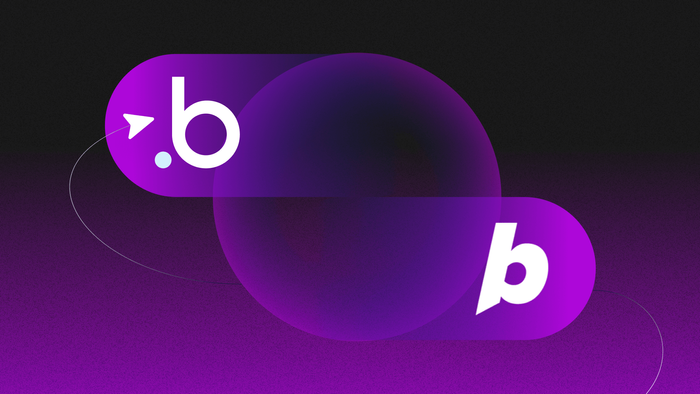The traditional software development process was measured in months or years.
Then no-code came on the scene, and that changed to weeks or even days.
Add AI to no-code and the timeline is now days, or even minutes.
As AI makes no-code development even easier and faster, we decided to test out the biggest AI app builders for ourselves. Bubble and Bolt are both popular tools for building apps with AI, so we put them up against one another to see which would perform best for different use cases.
Bubble is an AI visual development platform that allows anyone to build and launch fully functional web apps without code. Bubble combines AI app generation with drag-and-drop visual programming. That means you escape the curse of the blank page, but the robust visual programming tools allow you to customize every aspect of your app without writing (or reading) code. Anyone can build, launch, and grow an app while remaining in control the whole time.
Bolt is an AI-powered app builder that generates and iterates on code for your app alongside a coding environment for manual changes. It gives you a visual preview of your app alongside an AI chat to make iterations. It brands itself — and works well — as an AI assistant for developers looking to speed up familiar tasks and generate new code quickly.
Bubble vs. Bolt: Key factors
When choosing an AI app builder — whether it’s Bubble, Bolt, or something else — you need to keep in mind the 80% rule.
In comparing Bubble and Bolt, we focused not only on the initial output of the AI-generated code — that first 80% — but also on how well the platform supported both developers and non-developers with the final 20%. What often appears to be the last 20% often ends up being 80% of the work, so this question is crucial for deciding where to build.For example, you’ll want to think about factors like:
- Customization: How easy does the platform make it to iterate on and customize your app?
- Technical knowledge: Do you ever have to deal with code, or can those without coding knowledge understand their app at every point?
- Control: Does the AI cause builders to get “stuck,” or do you have full control through the whole process?
- Scale: Is scaling or building an app on this tool cost-prohibitive due to hidden fees related to AI usage?
These factors are particularly important for non-developers who might otherwise get stuck in “prompt purgatory” — endlessly prompting the AI without ever getting exactly what you actually want.
Bubble and Bolt both provide fast, “good-enough” output for the first 80% using AI generation. However, after the initial output, Bubble allows you to customize and iterate on the designs and functionality via a visual editor without having to code. Finishing that last 20% with Bolt requires some coding knowledge, even if you’re using the AI chatbot to iterate.
The Bolt platform, with its code-heavy interface, is slightly more developer-centric, with Bolt “highly recommending” that non-developers learn some basics of code to get the most from the platform.
| Feature | Bubble | Bolt |
|---|---|---|
| Initial output quality | ⭐⭐⭐⭐ | ⭐⭐⭐ |
| Design capabilities |
⭐⭐⭐⭐ Responsive design and drag-and-drop visual editor to make pixel-perfect UI, but missing AI-powered iterative editing. |
⭐⭐⭐ No visual editor. Speed and quality of design iteration via AI chatbot are both strengths. |
| Collaboration |
⭐⭐⭐⭐⭐ Real-time collaboration with adjustable permissions for each user. |
⭐⭐ Team plans but no real-time collaboration capabilities. |
| Backend and database support |
⭐⭐⭐⭐⭐ Native backend and database that doesn’t require technical expertise or extra costs to set up. |
⭐⭐⭐ No built-in backend; relies on external APIs (Firebase, Supabase). |
| Security and compliance |
⭐⭐⭐⭐ Bubble offers enterprise-grade security features, including SOC 2 and GDPR compliance, advanced encryption and monitoring, and custom privacy rules. |
⭐⭐ Bolt doesn’t offer built-in security or app privacy features but does work with platforms that offer strong security. |
| Deployment/hosting |
⭐⭐⭐⭐⭐ One-click deployment and native hosting. |
⭐⭐ No one-click deployment, third-party hosting through Netlify. |
| Technical expertise |
⭐⭐⭐⭐⭐ Best-in-class for developers and non-developers alike. |
⭐⭐⭐ Best suited for users with at least moderate technical expertise. |
Bolt is super flexible — it provides full access to the code and supports a number of popular programming languages. It gives you the ability to run a full coding environment in your browser and proactively builds functional (or at least interactive) UI based on your prompts. Better yet, it offers AI iteration, which allows you to add additional features and functionality just through prompting.
However, it’s best suited for users who already have some technical knowledge, and it’s weak for scaling. That’s because the AI can be inconsistent — sometimes it runs into errors or generates buggy code and doesn’t notice or know how to fix it. Overcoming this in Bolt requires you to edit the code manually.
Bolt also requires some technical expertise when setting up backend databases and hosting your app, so overall it’s more suited for those with technical experience who can work within Bolt’s AI limitations.
For non-developer builders serious about building and scaling an app, Bubble is the best choice. Built for speed and scale, Bubble provides a visual editor that ensures no-code stays codeless, while giving you full control and customization. It also offers an all-in-one environment where you can go from generating code with AI to building and customizing a fully functional app to launching and scaling.
Bubble’s AI doesn’t always perform perfectly, either — no LLM does at this point — but with a visual editor and the option for custom code, you have multiple options for editing and iterating on your code, depending on your experience level.
Bubble also offers production-grade tools like privacy tooling, enterprise-grade scaling and security, and built-in databases and hosting. Even better, you don’t have to pay for anything until you’re ready for launch.
Initial output quality
Obviously, one of the biggest and most obvious factors to consider when comparing AI builders is app output quality. There’s always room for improvement on the initial output, but the quality varies widely.
In this section, we compare how well the AI interprets prompts and the overall quality of the original output in terms of UI, functionality, and feature completeness.
Bubble AI-generated apps
We asked eight different users who were building AI-generated apps with Bubble to analyze output quality in seven core areas.
Here’s how Bubble scored — before the recent improvements from Claude 3.7 and the launch of image generation:
- Color, branding, and consistency: 3 / 5
- Spacing and layout: 4.5 / 5
- Copy, content, and context: 4 / 5
- Navigation and orientation: 4 / 5
- Readability and typography: 4.5 / 5
- Feature completeness: 3.5 / 5
- Feature functionality: 3 / 5
Bubble consistently delivered strong UI, with high rankings across the board for elements like spacing and layout, navigating, readability, and copy. Users agreed their app’s frontend looked great on the first result and agreed that Bubble’s AI accurately interpreted their prompts — both frontend and backend — without too much effort.
Bubble’s AI app generator just got even more powerful with Claude 3.7 Sonnet. Prompted yesterday? Try again now 😏 pic.twitter.com/uG0C6OGRGi
— Bubble (@bubble) February 25, 2025
The backend was where Bubble really stood out compared to other AI builders like Bolt, though. Bubble doesn’t just generate a beautiful frontend — it also creates a built-in database backend and functioning features.
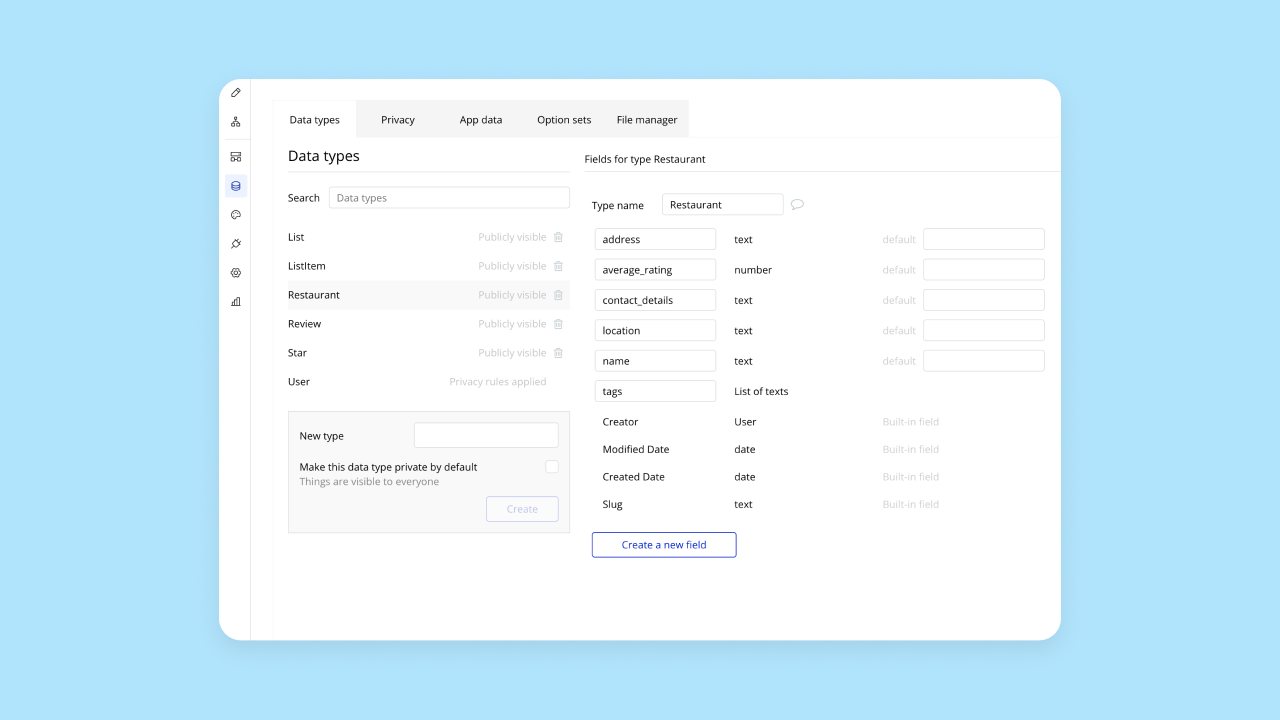
Although Bubble consistently generates all of this, our testers were mixed on its completeness. Some gave Bubble top scores in these areas, saying that Bubble’s AI generated all the expected features and they worked perfectly. Others said their app needed more iteration for full functionality.
Overall, this makes sense, since more complex ideas are (at this point) always going to need more iteration regardless of which platform or LLM model you’re using. That said, Bubble’s AI can get you about 80% of the way there for both frontend and backend development in under 10 minutes.
Bolt AI-generated app quality
First things first, the frontend. In our testing, Bolt generated a really beautiful frontend UI that aligned with our prompts and expectations. The design iteration was great as well — one of our testers said that it only took one prompt to entirely change the look and feel of the app.
The backend generated by Bolt’s AI was less polished and consistent. In one of our tests, Bolt generated one of the most complete apps from the other AI builders we tested, including more features than we asked for, robust and working functionality, and great sample data that made the app look and feel production-ready from the initial output.

However, in other tests, feature and functionality completeness was more limited.
The quality of your output likely depends on the complexity of your app and your prompt. Simpler apps are more easily generated by the AI with good results, while more complex ideas are harder for the AI to parse and generate.
Another major downside is that Bolt’s rate and token limits are very, well … limited. In one of our tests, Bolt didn’t even finish generating an initial output of our app before we ran into the daily rate limit. In general, we found we were only able to make 4–5 changes a day to an app before we hit the daily rate limit.
It’s not clear when you sign up or start on your project what the rate limit is, how quickly you’re going to reach it, or how many tokens your prompt(s) are going to use. This is a really opaque part of the process that makes for a frustrating experience.
Also, anything involving a backend and an API connection was a real headache. Bolt uses Supabase for a database connection, and our testers mentioned that Bolt’s process for connecting that backend database was complicated at times. Our non-developer testers couldn’t figure it out.
Which has better initial app output quality?
Bottom line: Both Bubble and Bolt had strong initial outputs. Their AIs interpreted the prompts clearly, delivered a clean and consistently impressive frontend, and backend features and functionality as well. Since Bubble has a built-in database, Bubble’s workflows and database functionality were more complete than Bolt’s (which requires a Supabase integration to really work).
Bolt’s rate limits also blocked our initial outputs on several tries, or limited how much we were able to create for free. Bubble’s platform allows users to use, edit, and iterate on their apps for free until they’re ready to deploy.
App development workflow
What’s the step-by-step process of creating an app with Bubble AI vs. Bolt? That’s what we’re looking at in this section.
How to create an app with AI on Bubble
Creating an app with Bubble AI is simple regardless of your technical experience. With Bubble AI, there are just three steps to get started:
Step 1: From the AI app generator, input a prompt that provides a concise description of your app along with key features.
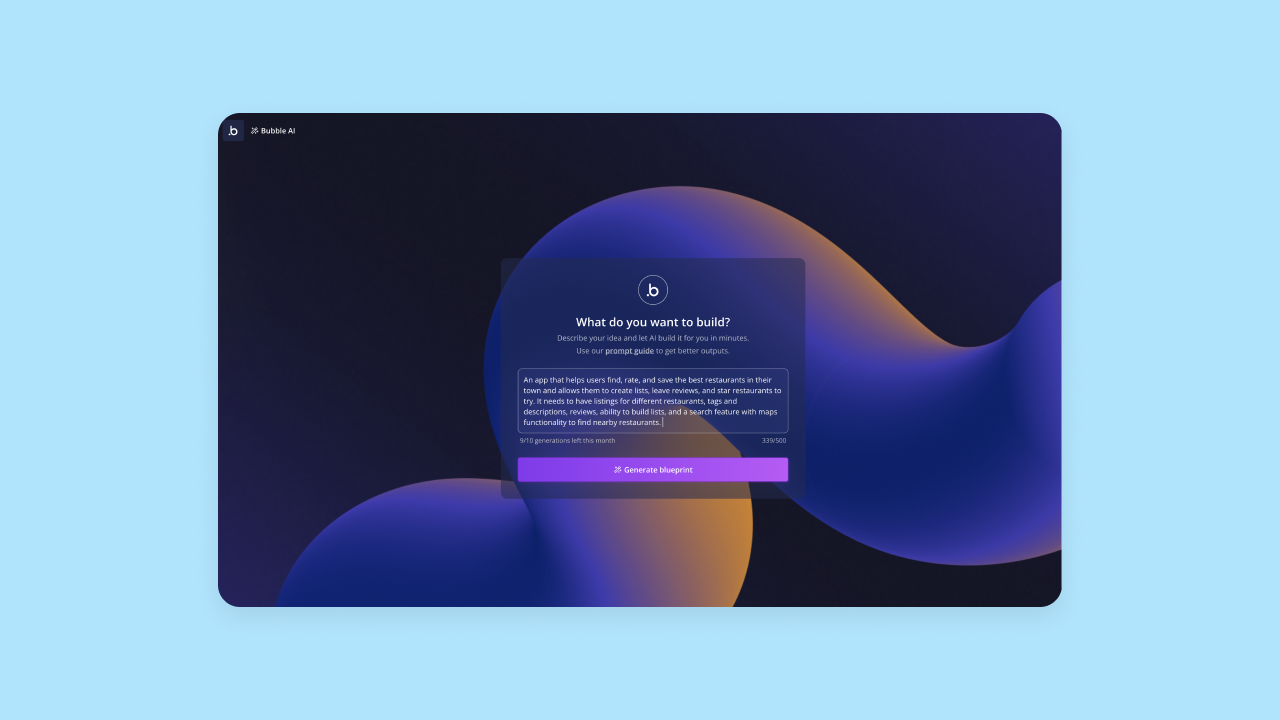
Step 2: Bubble AI will interpret your prompt and double-check with you by giving you an outline of key features. If it didn’t quite capture your vision, you can edit this or add additional features at this stage. When the outline looks good, click Generate to generate your actual app.
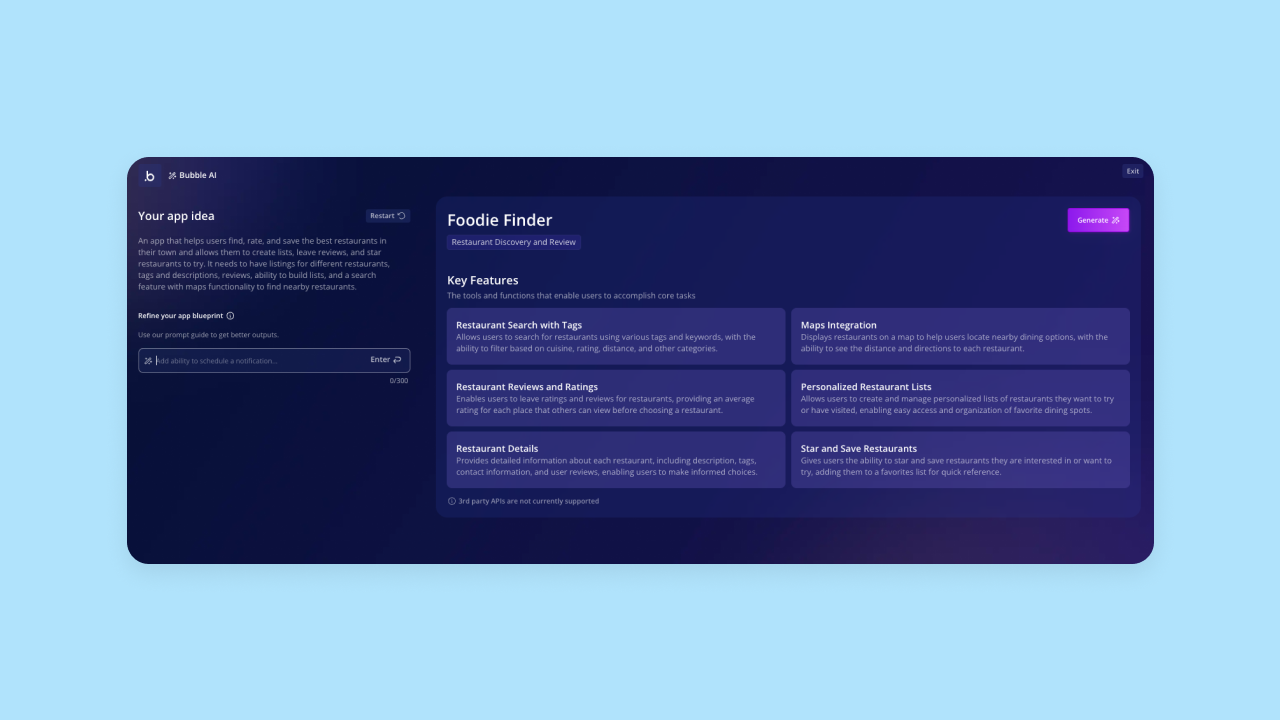
Step 3: It takes Bubble AI about five minutes to create the first draft of your app. You’ll get a functional app that includes frontend UI, backend databases with sample data, and workflows that make everything run. The features and functionality of your app should already work and be ready for more data and iteration.

Once your app is generated, you’ll be taken to Bubble’s visual editor. You can see individual pages, workflows, and databases — and everything that’s been created in each — by toggling between editor sections on the left-hand toolbar. Everything is edited and managed visually, so you have full visibility and control of each piece of your app, without having to dig into the code.
How to create an app with AI in Bolt
Creating an app in Bolt follows a similar process, with the main difference being that Bolt is code-based rather than visually-based.
First, you’ll prompt Bolt’s AI agent with your prompt, similar to Bubble.
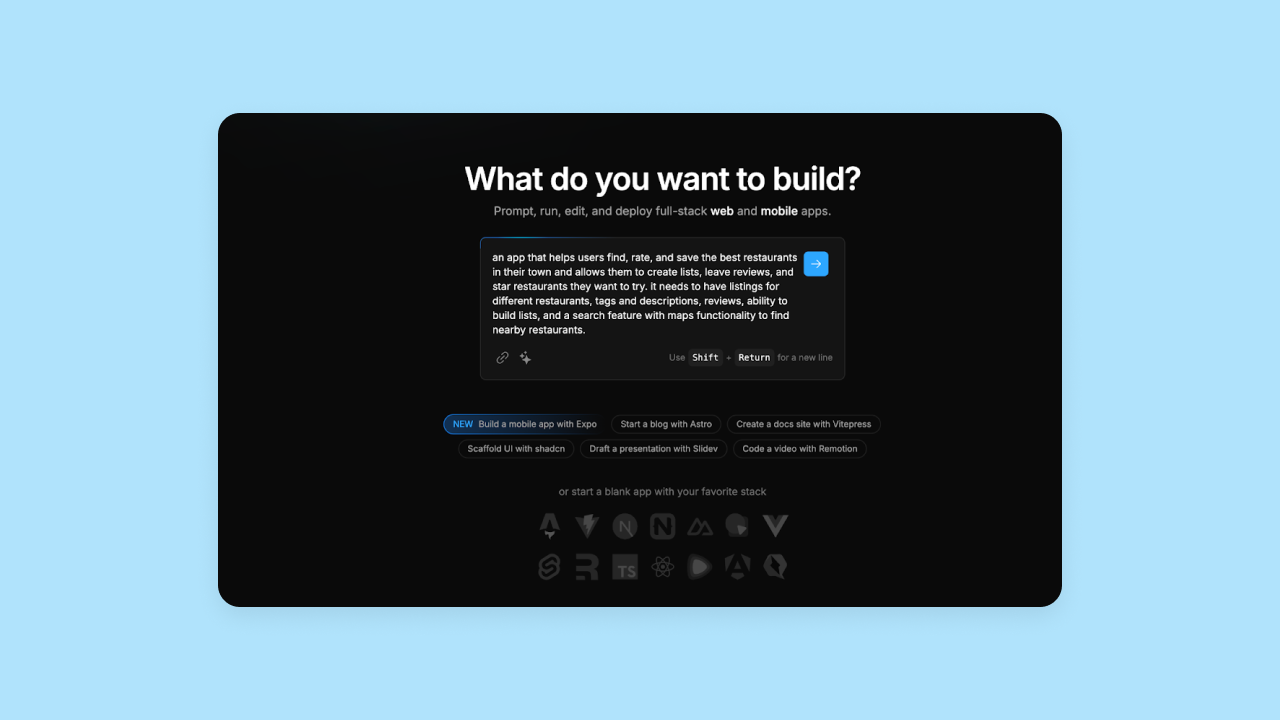
Bolt’s AI will immediately start generating code for your app. You’ll see the code in the right-hand view, while Bolt’s AI keeps you updated on what it’s building in the left-hand chat. Visually, Bolt’s platform looks very similar to Replit’s code-based IDE.
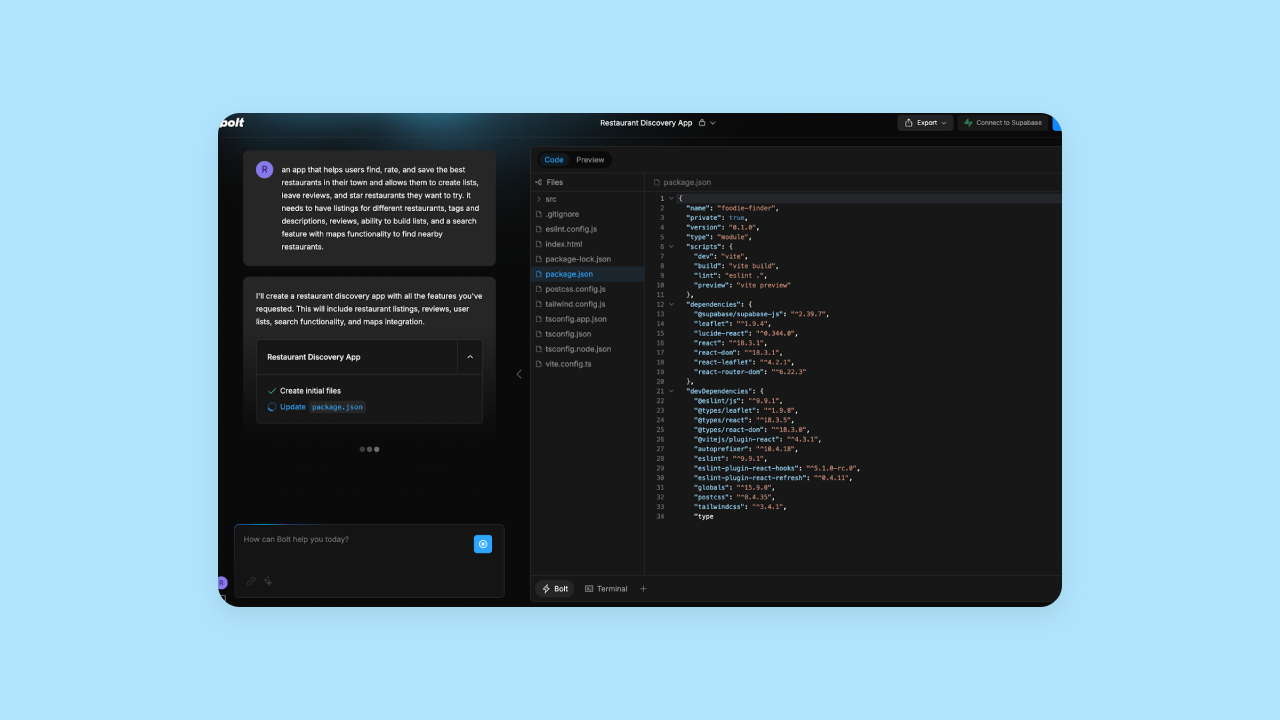
Bolt took about 5–7 minutes to generate our app. The code is all available under the “code” tab, and you can also see a visual (and semi-functional) preview.
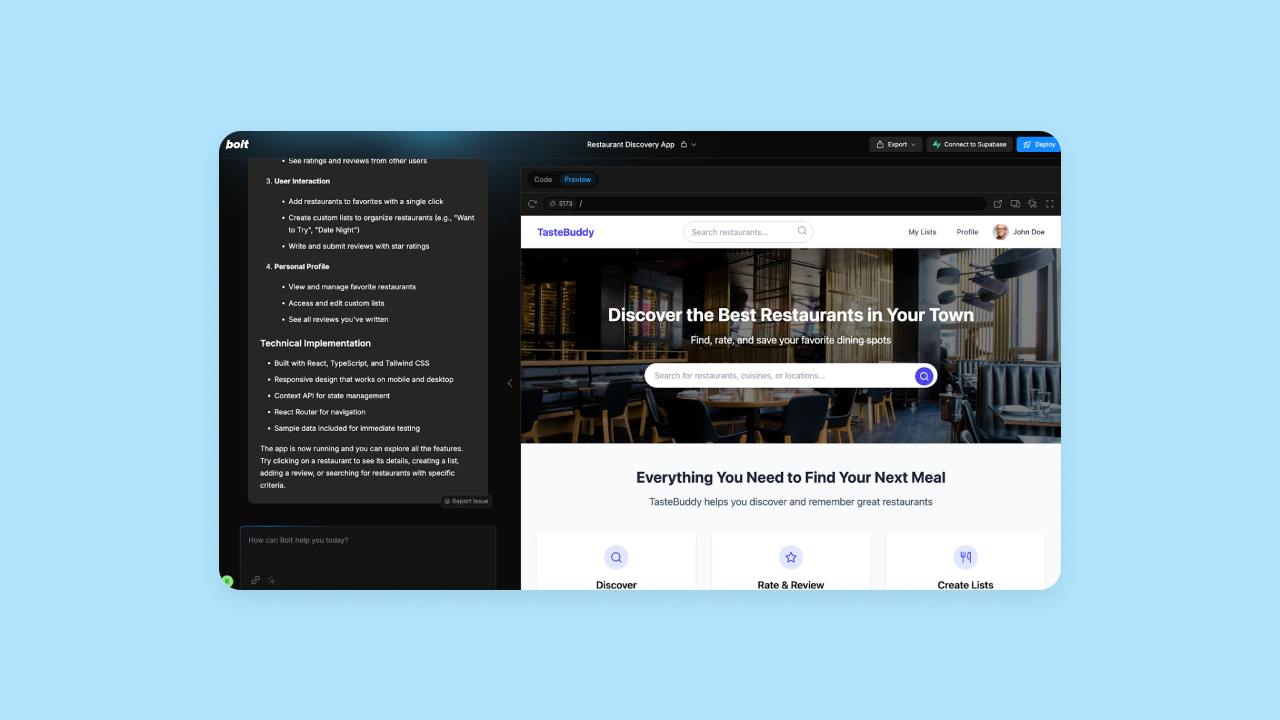
As mentioned above, Bolt’s UI generation was quite good, and it created one of the more complete apps from the tools we tested. Once your app is created, you can edit the code manually and see the updates in the preview. You can also use the AI chat to prompt for iterations (though we hit the rate limits really quickly on the AI chat).
On one of our tests, Bolt’s platform didn’t even finish generating the code and app preview before we hit the rate limit.

Which is the better app development workflow?
Bottom line: Bubble offers a simpler app development workflow, with a visual editor that allows even non-coders to edit their app directly. Bubble’s AI output was also faster than Bolt’s in our testing and didn’t lock iterations or output behind paywalled rate limits.
Design functionality
Being able to control the design of your app is critical, but different platforms provide very different design capabilities. In this section, we look at what each platform offers, as well as whether the design experience is truly no-code or whether you need technical expertise to finalize your app’s design.
Bubble design features
Bubble offers strong design features via the visual editor for a truly no-code experience. Compared to other AI builders, Bubble really shines in its design capabilities. For example, Bubble offers:
- Responsive design: Easily design for web, mobile, and other screen sizes with automatic responsive design. Plus, manual breakpoints and layouts so you can adjust exactly how your app displays on different screen sizes.
- Drag-and-drop visual design: An intuitive visual editor allows you to build and edit your design and make customizations without coding.
- Customization options: Bubble’s visual editor is extremely flexible and gives you complete control over every pixel. You can design your app to look exactly how you imagined it without having to write code or endlessly prompt an AI tool.
- Design imports: If you’re used to designing wireframes, mockups, or app screens in another design tool like Figma, you can import those designs directly into Bubble. Bubble will convert them seamlessly into a functional app so you’re not re-doing work your design team already did!
Unlike many AI builders, which are focused primarily on features and present code-heavy output, Bubble’s visual approach is much more manageable, particularly for non-coders.
Bolt design features
Bolt handles responsive design well, but other design features are a mixed bag. For example, Bolt does not offer a visual drag-and-drop editor, but Bolt’s AI does provide strong design iteration.
You can prompt Bolt’s AI chatbot to make changes to the design, and it generally works well. In our testing, one or two prompts were generally enough to change the entire look and feel of the app. The downside is that without a visual editor, if the AI gets stuck (which it does, often) or you max out your rate limits (which happens quickly), you’re blocked from making further changes unless you can edit the code yourself manually or upgrade to a higher-tier plan.
Bolt recently developed a Figma integration as well, allowing you to integrate a Figma frame into Bolt to create functional apps and prototypes directly from your design files. Bolt’s AI also works from images and screenshots. You can share a screenshot with the AI for reference (with mixed results).
As with other iterations on Bolt, rate limits remain a major roadblock. We reached them quickly in our test projects, and if you don’t have coding expertise, you’re blocked from iterating on your design or app further unless you upgrade.
Which has better design features?
Bottom line: Bubble offers a much more design-focused experience, with more design options and control. Ultimately, Bolt only offers design through their AI (which has strict rate limits) or manual coding, while Bubble offers a visual, drag-and-drop editor that gives you full design control and customization without code — the only AI app builder currently offering this.
Customizability
Customization is a must, and yet, different AI builders offer different levels (and difficulty) of customization. Another factor: How much customization is “locked” behind manual coding, and how much can be done visually or via AI?
Customization on Bubble
Bubble gives you nearly unlimited customizability. On Bubble, both developers and non-developers alike have built almost every kind of app or website, ranging from landing pages and e-commerce sites to SaaS apps, enterprise tools, AI tools, and more. Our AI capabilities are only building on this foundation of flexibility and customization, giving Bubble builders even more tools to leverage. With Bubble, our AI tools never lock you in — only give you more ways to speed up your workflow and overcome the blank-page dilemma, so you get exactly what you’re imagining in less time.
Bubble’s visual editor gives you full control over UI design, workflows, triggers, actions, data types, database structure, conditionals, and more. Plus, you can add reusable styles and elements to further speed up your design and development.
In short: Bubble gives you full control and customization options in every part of your app’s frontend and backend and supports all of it visually — no code needed.
Customization in Bolt
Bolt also offers a high level of customization. In the company’s video tutorials, you’ll see Bolt being used to clone popular apps, build portfolio sites, or create small web tools. No matter what you’re building, you do get full access to the code generated for your app, so you can make any changes you like directly to the code — giving you the same amount of customization available when writing code from scratch, but faster.
Bolt also allows users to customize iteratively via the AI chat, which users have mixed reviews on. On the upside, Bolt’s AI is pretty good at understanding the prompt and building the features you’re asking for. On the other hand, rate limits are a big blocker with Bolt, since it’s unclear when you’ll hit them (and we tended to hit them pretty fast).
If you don’t have traditional programming expertise, you’ll likely only be able to make 4–5 changes a day to your app with the AI unless you upgrade to higher tiers.
Which has better customization?
Bottom line: Bubble is designed for everyone to build just about anything you can imagine without needing coding knowledge or experience — and without needing to rely on AI, either. Of course, AI can massively speed up the process, but customization via the visual editor means you have full control the entire time.
Bolt offers full customization via code, but if you don’t have that traditional programming knowledge, you’ll be subject to AI’s limitations (and the rate limits Bolt sets on using their AI).
Mobile app development
While creating web apps with responsive design can capture some mobile traffic, being able to offer native mobile apps is a much better solution for most brands. We looked at which platforms support mobile app development and what capabilities are available.
Mobile app development on Bubble
Native mobile app development is currently in beta. That means you can use Bubble’s familiar visual no-code editor to build both web and native mobile apps, eliminating platform sprawl and reducing the learning curve needed to build for both web and mobile.
Bubble’s mobile app editor includes the ability to create React Native apps without code, adding native mobile elements, gestures, and functionality, all with the visual, drag-and-drop editor. For example, you can:
- Build from mobile-specific building blocks, rather than working from web pages and designing responsively.
- Use common mobile navigation patterns, like stack navigation (swiping or tapping), modal screens (pop-up screens over the main view), and bottom sheets (elements that slide up from the bottom of the screen).
- Add mobile-friendly interactions like swipe, long-press, and tap.
- Incorporate native device features, such as access to the camera, microphone, photo library, push notifications, and more.
Plus, you can preview and test everything using BubbleGo, our app for mobile testing. Then, publish your app directly to the Apple App Store and Google Play Store right from the Bubble editor.
Mobile app development on Bolt
Bolt also offers the ability to create native mobile apps (for iOS or Android) via Expo. The pros: You can use Bolt’s AI chat interface and visual preview to create UI, features, and functionality for a mobile app, with native mobile gestures and functionality. The cons: You need a bit more technical expertise to comfortably use Bolt and Expo together, plus deploy your app to native app stores, compared to Bubble’s all-in-one-place visual editor.
Which is better for mobile app development?
Both Bubble and Bolt provide functionality for creating native mobile apps, but, as with other features, Bubble makes it easier and more accessible to those without technical expertise, while Bolt’s platform is catered toward developers. Bubble uses the same visual editor to help you build and deploy mobile apps, while Bolt integrates Expo into their platform to allow you to build for mobile.
Collaboration
With AI, building apps as a team of one is easier than ever.
But if you’re looking to build, launch, and scale a customer-facing product or enterprise tool for your internal team, you’ll likely want more than one person to be able to work on it, iterate, and help you improve the app. This section compares how each of these tools supports collaboration.
Collaborating on Bubble
Collaborating on Bubble is simple. Bubble is designed for professional and enterprise use, so you’ll find all the tools you need to bring your whole team in and work together as you scale. For instance, depending on your plan, you can:
- Add as many users as you’d like to collaborate on an app with you.
- Invite users to just one or all of the apps you own.
- Set access permissions for each user, including edit access for different spaces (like UI vs. databases).
- Collaborate together on Bubble in real time.
Collaborating in Bolt
Bolt also makes collaboration possible on its team plan. You can add as many people as you’d like to your team. Free team members can collaborate on public projects. Paid team members can collaborate on private projects, collections, and GitHub repositories with your team.
Which is better for collaboration?
Both Bolt and Bubble provide collaboration tools for teams — a big win over other AI app-building platforms that are only built for individual work. Bubble offers slightly more control for larger teams who need stricter privacy and editing access compared to Bolt, where team members can either edit everything or nothing.
Framework support
Framework support considers how flexible your tech stack will be and what programming languages will be supported by a given platform.
Some platforms generate code in one specific programming language, while others are compatible with a number of languages and frameworks.
Framework support with Bubble
Bubble uses a visual programming language unique to the Bubble platform. For non-developers, this is great news: You don’t have to know any coding languages to build, test, iterate, debug, or scale your app. Instead, everything is managed visually via Bubble’s drag-and-drop editor, including workflows and logic!
For technical builders, adding custom code is always an option, though it’s not required.
Since Bubble apps are built and hosted all on Bubble, it’s not necessary to convert your Bubble apps into specific programming languages — you get a one-stop shop with Bubble and a visual programming language that can stand on its own.
Bolt framework support
Bolt supports a number of popular frameworks, including React, Angular, Next.js, and Tailwind CSS frameworks. Note that Bolt does not support non-web languages like Python, C#, or C++. For developers who are used to working within JavaScript or CSS frameworks, Bolt can probably support your project.
Which has better framework support?
Bottom line: Bolt supports more popular frameworks than Bubble, but it’s still limited and may cause some issues if you use tech outside of those frameworks. Bubble offers an all-in-one framework unique to the Bubble ecosystem that ensures everything you need stays connected and doesn’t require you to learn or know any particular programming language.
Integrations
Framework support is one element of ensuring your app builder integrates well with your existing tech stack. Integrations are another.
A solid set of integrations can significantly expand the possibilities and capabilities of your platform and the app you create, not to mention ensure that your app development connects easily to other tools you’re already using. And existing integrations are created and maintained by an expert, giving you built-in updates and stability.
Bubble integrations
Bubble has thousands of plugins and integrations you can use to build and expand the capacities of your app, including:
- OpenAI and Chat-GPT 4
- Anthropic Claude AI
- DALL-E
- Github
- Figma
- Stripe
- Paypal
- Google Suite products
- and thousands more
But best of all, you aren’t limited only by what Bubble or our community has created and used in the past — you can connect any service or platform to your Bubble app via our API connector. Input the API token on your Bubble backend and create your own integrations to whatever tools you need.
Bolt integrations
Bolt currently offers only a few integrations:
- Netlify (for deployment)
- GitHub
- Supabase
- Firebase
- ElevenLabs API
- GrokAI
- Gemini
With two options for databases and a deployment integration, you have what you need to build a full-stack app. However, Bolt’s integrations are rather limited compared to other AI app builders, and if you want to connect to other tools, you’ll have to build out most integrations manually.
Which has better integrations?
Without a doubt, Bubble has a significantly more extensive library of integrations and plugins that are ready-made — just “plug and play” to connect to thousands of other apps and tools. With Bolt, you’ll mostly have to code your own integrations with the exception of a few basic add-ons.
Iteration and optimization
For this section, we considered two types of performance improvements for your app: code optimization and code iteration.
Code optimization — also known as code refactoring — means adjusting code that’s already working to make it run faster or more efficiently. This is especially important when building with AI, as AI code tends to be bloated and buggy, making refactoring more essential. Code iteration is changing or adding to the code to include new features or functionality in your app.
Bubble iteration and optimization
Bubble uses a visual programming language, so with Bubble, code optimization (or refactoring) isn’t necessary at all. Sometimes, as businesses grow and scale on Bubble, they want to find ways to make their app run more efficiently to optimize costs — this could be considered a kind of refactoring. If and when you reach this point, though, it’s a good problem to have — and you’ll find plenty of resources for how to do this in our guides and our community. However, it’s not something you’ll need to do continuously from day one, as with traditional refactoring.
What you will want to do from the beginning is iteration. No matter how carefully you prompt or build, you’ll always need to do some adjusting and iterating as you go to get exactly the features and functionality you need.
On Bubble, all iteration happens visually via our drag-and-drop editor. You can adjust and add functionality, UI / UX features, workflows, complex logic, and everything else you’ll need, all without interacting with code. Bubble doesn’t currently support AI-powered iteration, though it’s coming soon!
Bolt code iteration and optimization
Bolt doesn’t offer AI-driven code optimization, which is a major downside for users without technical expertise. AI-generated code tends to be bloated, which can definitely impact the speed and performance of your app, but code optimizations must be done manually.
Bolt does offer AI-driven code iteration. If you want to make a change to the UX, logic, features, or functionality of your app, simply describe the changes you want to see in the Bolt AI chat, and the AI will generate or change your existing code to reflect the new updates.
While Bolt’s AI does a pretty good job understanding and actioning prompts, there are still some downsides to keep in mind:
- Bolt’s biggest weakness is generating error-free, complete code. The previews fail a lot, and the code crashes too, which means that Bolt’s AI generates a lot of buggy code without being able to fix it automatically.
- Rate limits are prohibitive. As we’ve mentioned, the rate limits make it difficult to test out the platform or work on your project quickly and intensively if you’re using AI.
- Complex workflows still trip it up. Bolt doesn’t have a sophisticated AI planning agent, so complex logic or multi-step functionality can still trip up the AI. You have to prompt it carefully and generally do one step at a time.
That said, Bolt’s AI still makes it a lot faster (compared to traditional development) to get out mostly functional code with modern UI.
Which is better for iterations?
Bottom line: Bolt has the lead on AI-driven improvements by offering AI-powered iterative chat (although that’s coming soon to Bubble, too). However, Bolt requires some technical expertise to truly iterate on your app, as the AI often creates errors it can’t fix. Bubble uses a visual editor for iterations, keeping you in the driver’s seat the entire time, regardless of your technical expertise.
Security
Security and privacy features make a huge difference depending on what you’re using an AI app generator for. A platform without many security features may be fine for prototyping, but it will be difficult to launch a production-grade app ready for end-users — and their personal data.
For this section, we compared how well each platform protects your app data and customer data, what security certifications and features are built into the platform, and how easy it is to set them up, even without technical experience.
Bubble security features
Bubble offers strong security “out-of-the-box” with built-in, enterprise-grade security features that protect both your app data and your end-users’ data. Bubble is SOC 2 Type II compliant, meets GDPR standards, and provides enterprise-grade infrastructure (AWS) and data encryption (HTTPS with SSL encryption and encrypted at rest with AES-256 via AWS RDS). In plain English: Your data is automatically encrypted both when it’s stored and when it’s being sent between users and your app.
Bubble also allows you to use the visual editor to set up app-level privacy rules and restrictions, so you get full control over your app’s privacy settings without having to code. Privacy rules aren’t set up automatically, but Bubble will guide you through it to make sure you have a secure app.
To make things even easier for you, Bubble’s built-in Flusk security tools give you the option of running automated security checks that scan your app for potential vulnerabilities and alert you before they become problems.
Other built-in security features include:
- Built-in user authentication with options for 2FA, SSO, and more.
- Vulnerability testing
- DDoS protection and Cloudflare blocking to prevent attacks
- Flusk monitoring to identify vulnerabilities and get proactive alerts
Plus, Bubble has a strong, established track record of hosting and maintaining apps with thousands of users around the world — a testament to Bubble’s security, stability, and production-grade environment.
Bolt security features
Bolt doesn’t have many built-in security features — in part because Bolt is not responsible for hosting your app or managing your databases.
Bolt integrates with external databases like Supabase, so your app-level security will be determined by a) how you build the app, which requires you to have some level of familiarity with app privacy settings, and b) your database security. (Supabase, for example, has strong security features.)
The same goes for deployment and hosting — your app will only be as secure as the servers you host it on. Netlify is the default hosting provider for Bolt, which provides strong infrastructure security and compliance standards, but it puts the responsibility for app-level security and compliance on the builders.
All that to say: It’s very possible to build a secure app with Bolt and their partner platforms, but it requires more expertise and an understanding of what needs to be done (and how!) to fully secure your app and app data.
Which has stronger security?
Bottom line: Bubble offers significantly more robust security features and makes it easier to set them up, even without technical expertise. Bubble’s security-grade features and compliance certifications ensure your app and end-user data is always stored and sent securely, and it ensures your app will comply with necessary security standards. Visual tools for privacy settings also allow non-programmers to set up custom privacy rules for your app with just a few clicks, no code needed.
Bolt doesn’t provide built-in security or privacy settings, but it does integrate with platforms that offer strong security. However, it’s up to the developer to set up and customize those settings accurately.
Deployment and hosting
Easy deployment and hosting of your app makes it simple to get your app live and shared with customers, stakeholders, or anyone else who you want to use your app. In this section, we compare how each of these platforms manages launching and hosting for your app.
Deploying and hosting Bubble apps
Bubble makes deploying and hosting your app super easy — it’s all done within the Bubble ecosystem. When you’re ready to publish your app, just click the “Deploy” button in the header nav bar.
Bubble also offers built-in hosting, which means that when you’re ready to push your site or app live, it will live on Bubble servers. All-in-one hosting makes updates and iterations faster while giving you fewer platforms to juggle (and pay for!).
Deploying and hosting Bolt
Bolt also offers one-click deployment and hosting via Netlify. By default, when you deploy your app through Bolt, it hosts it on Netlify and then you can claim that URL and add the project to your own Netlify account manually.
So it’s not exactly one-click, but it’s also pretty simple for those experienced with basic web hosting. Bolt also allows you to export the code for self-hosting.
Which makes deployment and hosting easier?
Bottom line: Bolt and Bubble both offer simple deployment and hosting. Because Bubble provides hosting, the process is more streamlined and a bit simpler compared to Bolt, which requires you to self-host or use a Netlify integration to own your site.
Education
Sure, AI makes software development a lot easier and faster. But no matter how easy it gets, there’s always going to be some need for education about the platform you’re using, the features available, how to troubleshoot when you (or the AI) get stuck, or if you want to build something more customized.
In this section, we evaluated the level and quality of education each platform provided.
Bubble education materials
Bubble has a huge library of resources: everything from YouTube videos to step-by-step guides, detailed courses, one-on-one coaching, bootcamps, our community forums, our technical manual, and more.
Since we’ve always been a platform for all kinds of builders, we’ve worked hard to create resources for all levels and learning styles. Whether you’re brand new to building or an experienced developer, there are resources for you to upskill and learn to use Bubble.
If you’re new to building with AI, start with our course for Bubble beginners — we will walk you through the basics of the Bubble platform, our visual programming language, and our AI tools. Our YouTube channel is also a great place to find tips on building with AI or learn how apps work on Bubble as you start to build your own!
Bolt education materials
Bolt offers some technical documentation and a few video tutorials, but nothing comprehensive or really geared toward beginners. They do have some video walkthroughs, which are helpful (found either on their YouTube channel or via their technical docs).
They do have a how-to-get-started guide, but it’s pretty sparse as well. Bolt is a newer platform, so it makes sense that they’re still building this out, but it can be hard to follow or find the information you need, especially if you’re a beginner.
Which has stronger education?
Bottom line: Bubble takes the cake on education, by far. Bubble has a significant library of educational resources for all skill levels, a detailed manual for technical documentation, and tons of tutorials, walkthroughs, and build guides in various formats. Bolt offers some technical documentation and a few walkthroughs, but their resources are currently pretty sparse.
Required technical expertise
The idea with an AI app builder — or no-code in general — is to make software development more accessible to anyone, not just those with a technical background.
However, some AI app builders are more or less suited to those without a lot of technical expertise. Even if an AI agent is generating the app’s code for you, it’s crucial to understand how much technical expertise is needed to use the platform, iterate on the code, and manage your app long-term.
In this section, we compare how technical each platform is beyond the initial code generation.
Bubble technical approachability
Bubble is made for developers and non-developers alike. WIth a visual development platform that’s truly visual but with the option to add custom code if you want, you get the best of both worlds, and the platform is accessible for any skill level.
As a result, everyone from developers to product managers, founders, individual hobbyists, and more build on Bubble.
Of the AI-powered app builders we tested, though, Bubble is the best choice for non-developers. On Bubble, every part of the software development process is accessible for those without a technical background — not just the initial design mockups and MVPs. Because Bubble is built entirely on a visual programming language, you can control your workflows, data, logic, and functionality all visually — no code needed.
Starting with AI on almost any platform gives you a massive head start and speeds up development time exponentially. But Bubble makes it easier and more accessible to go beyond the Day 1 output that AI provides. Though a technical background can make it easier and faster to build on Bubble, someone without a technical background at all can make an app in just weeks on their own on Bubble.
Bolt’s technical approachability
Bolt isn’t really designed for those without technical experience. If you don’t have coding knowledge, you can definitely use the Bolt app — and it’s pretty easy to get started — but you will run into some learning curve issues pretty quickly. For example:
- The Supabase integration is more complicated than it needs to be, and can be an unnecessary hurdle to setting up databases. For full-stack apps, it can be tough to set this up purely through AI prompting on Bolt.
- Without a visual editor for making changes to your app, your only options for revisions are prompting the AI (see limitations above) or directly editing the code.
Bolt’s platform and technical documentation are geared toward developers. The Bolt team even recommends that non-developers learn coding basics before using Bolt to get the most from the platform, signaling that they’re not really focused on being beginner-friendly.
In addition, many early users and tutorials show Bolt as an assistant to speed up familiar tasks, provide a UI clone of common apps, or build prototypes quickly using a familiar framework that can be customized or built upon later. Bolt can be used by non-developers, but it’s better as an AI assistant to save time for experienced devs.
How do Bolt and Bubble stack up in required technical expertise?
Bottom line: Bolt is not designed for beginners. Although builders without technical expertise can use it, you’ll have to develop some to make your app fully functional.
Bubble is designed for everyone, regardless of technical experience. With a fully visual platform, AI assistance, and a true no-code building experience, it’s truly accessible for those without a technical background.
Bubble vs. Bolt: Which is right for you?
Bubble and Bolt both offer AI-powered app generation that delivers a functional frontend and backend. However, the tools are both pretty different in how they work and the level of technical expertise required.
Bolt is essentially an AI assistant for traditional developers, allowing experienced coders to spin up new apps and prototypes quickly by riffing off of common apps to quickly create core features and providing code in familiar frameworks for the developer to iterate on. It can also be a useful tool for beginner developers who are looking for a tutor or a coach to help them develop code or learn a new framework.
Bubble is an AI-powered visual development platform that combines the speed of AI with the ease of visual development to give everyone the ability to create production-grade apps and enterprise software. Even non-coders get full control and customization through the visual editor, combined with the speed of AI generation to eliminate the blank page dilemma and introduce you to the platform.
On other platforms, where AI hits a wall, develops buggy code, or leaves you stuck in prompt purgatory, Bubble gives you full control over the final product without the guesswork or manual coding.
Plus, you get built-in hosting, strong integrations, a huge community with tons of resources, and a platform you can understand without a technical background, which makes managing and scaling all aspects of your app accessible for anyone.
Curious how other no-code AI builders stack up? Check out our other comparisons:
Of course, the best way to get a feel for a platform is to test it out for yourself. See how Bubble AI works and start building in our visual editor for free.
Build for as long as you want on the Free plan. Only upgrade when you're ready to launch.
Join BubbleLATEST STORIES

Bubble Wrapped 2025: Recap of Our Year of Building Together and Community Awards
From AI agents to native mobile apps, 2025 was a year of serious building. Explore our building stats, celebrate Community Awards winners, and see what we’ve accomplished together.


AMA Recap: Emmanuel on AI Agent Expansion, Mobile Priorities, and Platform Updates
Emmanuel answered questions on the AI Agent roadmap, including when it's coming to existing apps, plus updates on mobile, workload units, and what's ahead for Q1.

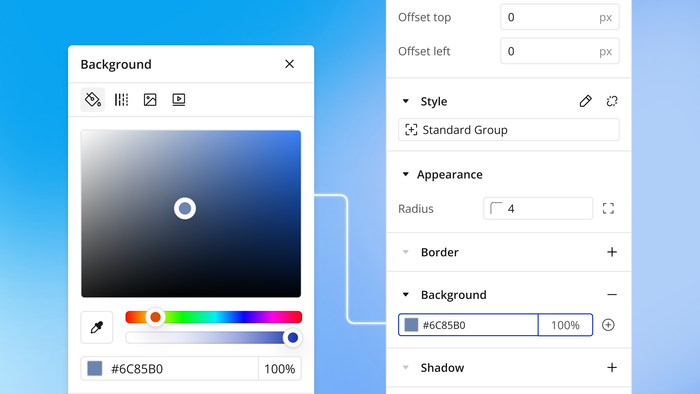
See How We Redesigned the Property Editor for Better Building
The redesigned property editor makes Bubble more intuitive for new builders and more efficient for experienced ones. Learn what changes to expect.

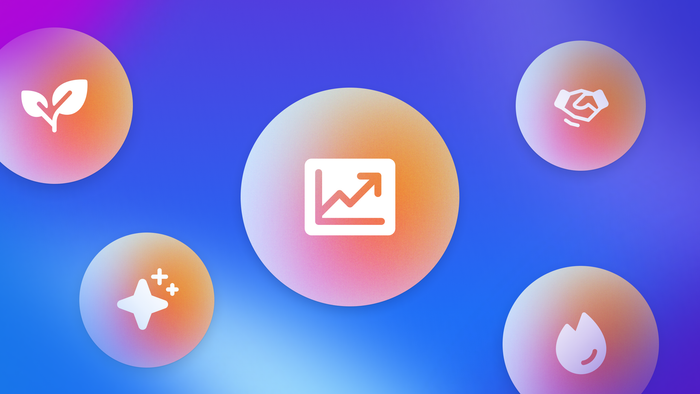
Meeting the Moment: What It Actually Takes to Evolve in the AI Era
We asked every employee to recommit to our vision of replacing code with AI visual development. 95% chose to stay. Here's why that matters.

